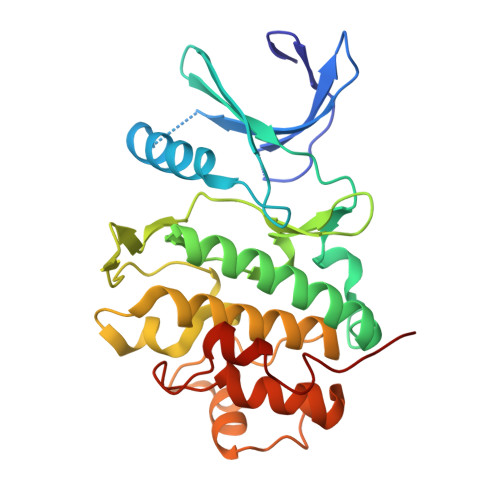Discovery and Optimization of N-Heteroaryl Indazole LRRK2 Inhibitors.
Logan, K.M., Kaplan, W., Simov, V., Zhou, H., Li, D., Torres, L., Morriello, G.J., Acton, J.J., Pio, B., Chen, Y.H., Keylor, M.H., Johnson, R., Kattar, S.D., Chau, R., Yan, X., Ardolino, M., Zarate, C., Otte, K.M., Palte, R.L., Xiong, T., McMinn, S.E., Lin, S., Neelamkavil, S.F., Liu, P., Su, J., Hegde, L.G., Woodhouse, J.D., Moy, L.Y., Ciaccio, P.J., Piesvaux, J., Zebisch, M., Henry, C., Barker, J., Wood, H.B., Kennedy, M.E., DiMauro, E.F., Fell, M.J., Fuller, P.H.(2024) J Med Chem 67: 16807-16819
- PubMed: 39231262
- DOI: https://doi.org/10.1021/acs.jmedchem.4c01627
- Primary Citation of Related Structures:
9CE4 - PubMed Abstract:
Inhibition of leucine-rich repeat kinase 2 is a genetically supported mechanism for the treatment of Parkinson's disease. We previously disclosed the discovery of an indazole series lead that demonstrated both safety and translational risks. The safety risks were hypothesized to be of unknown origin, so structural diversity in subsequent chemical matter was prioritized. The translational risks were identified due to a low brain Kp u,u in nonhuman primate studies, which raised concern over the use of an established peripheral biomarker as a surrogate for central target engagement. Given these challenges, the team sought to leverage structure- and property-based drug design and expanded efflux transporter profiling to identify structurally distinct leads with enhanced CNS drug-likeness. Herein, we describe the discovery of a "reinvented" indazole series with improved physicochemical properties and efflux transporter profiles while maintaining excellent potency and off-target kinase selectivity, which resulted in advanced lead, compound 23 .
Organizational Affiliation:
Merck & Co., Inc., 33 Avenue Louis Pasteur, Boston, Massachusetts 02115, United States.
















